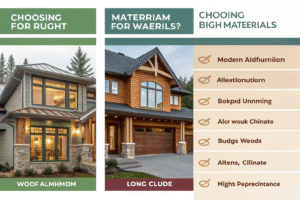When choosing window frames, two materials often come up—aluminum and uPVC. Both have unique advantages, but understanding their differences helps you choose the best one for your project.
The main differences between aluminum and uPVC window frames lie in strength, appearance, insulation, durability, and maintenance.
Whether for a residential home or a commercial building, the right material can enhance performance, design, and long-term value. Let’s compare aluminum and uPVC frames across key aspects.
Strength and structural stability
Strength determines how well a window handles stress, weight, and weather conditions.
Aluminum window frames are stronger and more rigid than uPVC, making them ideal for large openings.
Built for performance
Aluminum’s superior strength-to-weight ratio allows for thinner frames and larger glass panels without compromising stability. It performs better in high-rise buildings, windy regions, or large-span designs.
Our factory uses 6063-T5 aluminum alloy, extruded with precision for consistent structural integrity. In comparison, uPVC works well for smaller windows but can deform under heat or heavy loads over time. For large architectural glazing or commercial projects, aluminum remains the preferred choice.
Design and appearance
A window’s visual style plays a huge role in architectural impact.
Aluminum frames offer slimmer profiles and modern aesthetics, while uPVC has a softer, more traditional look.
Sleek versus subtle
Aluminum frames are ideal for contemporary architecture—they allow more glass area and less visible framing. They come in a wide range of finishes such as matte, metallic, anodized, or wood-grain coatings.
Our in-house powder coating and anodizing lines offer more than 100 color options. For designers who prefer warmer tones, we also provide wood-grain transfer finishes that mimic real timber. uPVC frames, while clean and simple, generally offer limited color options and a bulkier appearance.
Thermal insulation and energy efficiency
Insulation performance affects comfort and energy bills.
uPVC provides natural insulation, while thermal break aluminum systems can achieve comparable energy efficiency.
Keeping heat where it belongs
uPVC is a non-conductive material, which means it doesn’t transfer heat easily. This makes it efficient for insulation in standard climates. However, with modern thermal break aluminum, a nylon barrier separates the interior and exterior layers—greatly improving energy efficiency.
Our thermal break aluminum systems meet international insulation standards (NFRC, AS2047, CE). Combined with low-E or double glazing, they match or even exceed uPVC’s performance while maintaining slim, elegant frames.
Durability and lifespan
Window frames should last for decades with minimal wear.
Aluminum is more durable and weather-resistant than uPVC, especially in extreme climates.
Built to last
uPVC performs well indoors but can fade, warp, or become brittle under prolonged sunlight exposure. Aluminum, on the other hand, is corrosion-resistant, non-deforming, and retains its finish for decades.
Our aluminum frames undergo 5,000-hour salt-spray and UV exposure testing to ensure color stability and surface protection. With proper care, aluminum windows can last 25–30 years or more—making them a long-term investment for any property.
Maintenance requirements
The best window systems are the ones that need little upkeep.
Both aluminum and uPVC require low maintenance, but aluminum is easier to clean and resists surface staining.
Easy care for everyday living
A quick wipe with mild detergent and water is enough to keep aluminum or uPVC windows clean. However, uPVC can discolor over time, especially in harsh sunlight, while aluminum retains its sleek appearance.
Our factory’s powder-coated finishes are scratch-resistant and easy to clean, requiring no repainting or sealing. This makes aluminum ideal for busy homeowners and large commercial projects that prioritize low maintenance.
Cost and long-term value
Budget often determines the final decision—but consider long-term performance too.
uPVC is generally cheaper upfront, while aluminum offers higher long-term value through durability and strength.
Balancing budget and performance
uPVC’s lower cost makes it popular for small-scale residential use. However, aluminum’s longer lifespan and superior performance often make it more cost-effective over time. It also adds greater resale value due to its premium appearance and low maintenance.
At our factory, we provide both standard and thermal break aluminum systems at competitive prices. For builders and architects, this ensures the right balance between quality, budget, and sustainability.
Environmental impact and recyclability
Sustainability is becoming a priority in modern construction.
Aluminum is 100% recyclable, while uPVC recycling is limited and energy-intensive.
Building for a greener future
Recycling aluminum requires only 5% of the energy needed for new production, making it one of the most eco-friendly materials available. uPVC recycling is less efficient and can release harmful emissions if not handled properly.
Our factory follows environmentally friendly production processes, using recycled aluminum billets and eco-safe powder coatings. We also provide sustainability documentation to help clients meet LEED or Green Star certification requirements.
Ideal applications for each material
Both aluminum and uPVC perform well—but in different settings.
Use aluminum for large, modern, or high-performance projects, and uPVC for smaller, low-budget installations.
Matching the material to your project
- Aluminum: Best for villas, offices, commercial buildings, and coastal properties.
- uPVC: Suitable for apartments or small houses in mild climates.
Our engineering team helps clients choose the best frame material based on project goals and local conditions. Whether you need thermal break aluminum systems or standard cost-effective solutions, we can customize products to fit your exact requirements.
Conclusion
Both aluminum and uPVC windows offer unique advantages. uPVC provides affordable insulation for smaller projects, while aluminum delivers unmatched strength, design flexibility, and longevity.
With our factory’s in-house R&D, extrusion, coating, and production capabilities, we create custom aluminum window systems designed for performance, aesthetics, and sustainability.
👉 Contact us today to compare materials, request samples, or start your next window project with our professional manufacturing team.

